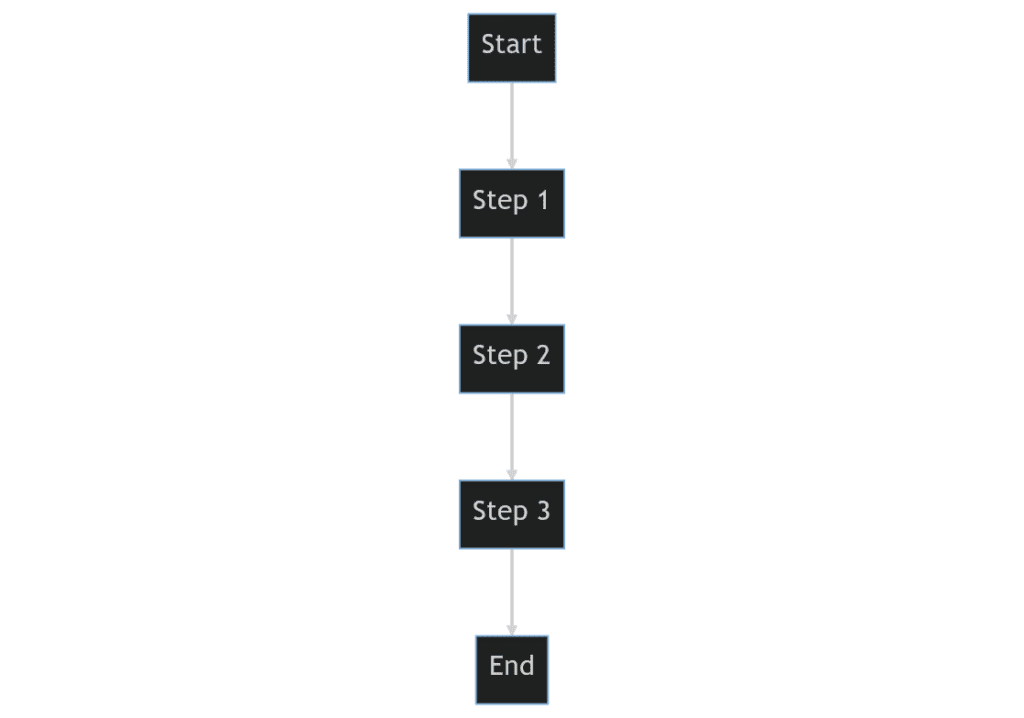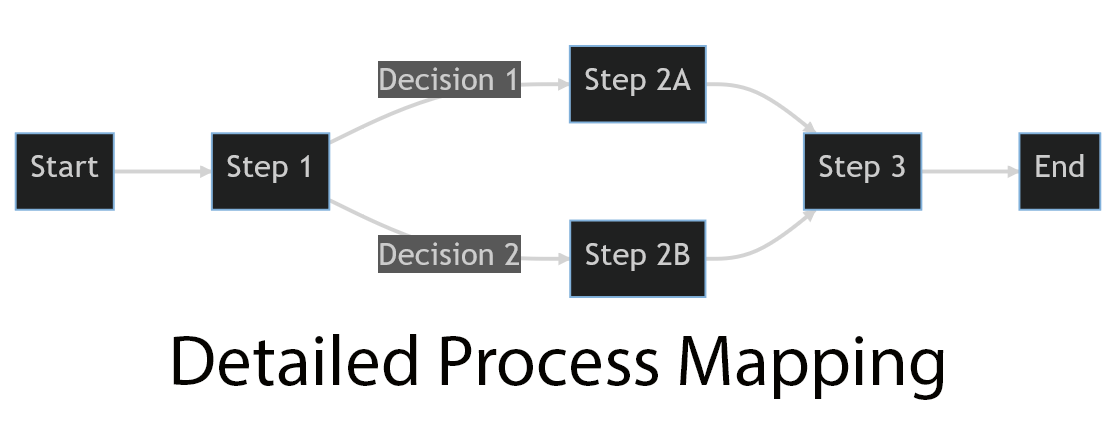Process mapping, an integral part of the Six Sigma methodology, is a versatile tool that allows businesses to visualise and understand their processes better. By creating a visual representation of a process, we can analyse its flow, identify areas of inefficiency, and devise strategies for improvement. This powerful technique can be applied to any process, whether it’s a manufacturing line, a customer service operation, or an administrative procedure.
In the context of Six Sigma, a methodology focused on reducing errors and increasing efficiency, process mapping plays a particularly important role. It facilitates a thorough understanding of the current process (also known as the “as-is” process), which is crucial before any changes or improvements can be made.
Process mapping not only provides a clearer picture of the individual steps in a process but also illustrates how these steps interconnect. It sheds light on the relationships between different tasks, the sequence in which they occur, and how they contribute to the overall output.
The benefits of process mapping in Six Sigma are manifold. By making the process transparent, it helps identify bottlenecks, redundancies, and unnecessary steps that may be slowing down the process or causing errors. This leads to an understanding of where changes need to be made and how to make them, ultimately resulting in a more efficient and effective process.
In this comprehensive guide, we will delve into the details of process mapping in Six Sigma. We will explore the challenges you might face, guide you step-by-step on how to create a process map, discuss different types of process maps and common mapping techniques, and provide concrete examples to illustrate these concepts. Whether you’re a Six Sigma beginner or an experienced practitioner, this guide will offer valuable insights to enhance your process mapping skills and knowledge.
Stay tuned as we embark on this journey to master process mapping in the realm of Six Sigma.
In the next section, we’ll start by gaining a deeper understanding of what process mapping is and its role in Six Sigma.
In This Article
Understanding Process Mapping
Process mapping is a technique that visually describes the flow of activities involved in a process. It’s like a roadmap of a process that outlines every step involved from start to end, making it easier to understand, communicate, and identify potential areas of improvement.
At its core, a process map is a graphical representation of a process.
It captures details on how the process operates, the steps that add value to it, and those that do not. It’s a simple yet powerful tool, adding great value to documenting everything happening during a manufacturing or service process.
Process maps typically capture the following:
- Key requirements of the process output or deliveries
- Main input parameters
- The main outputs of each step
- Steps that add value to the process
- Steps that do not add value to the process.
Process mapping becomes particularly important in the context of Six Sigma, a methodology that aims to improve business processes by reducing variability and eliminating errors. In Six Sigma, process maps serve as a foundation for identifying problems and seeking solutions.
In essence, process mapping in Six Sigma is a tool that helps to illuminate the path towards process improvement. By creating a visual diagram of a process, teams can see exactly what is happening, identify potential bottlenecks or areas of inefficiency, and plan strategic improvements.
In Six Sigma methodology, the process map begins with a clear definition of customer requirements and ends with the provision of customer satisfaction, keeping the customer in focus all the time.
The process map in Six Sigma, therefore, is not just a tool for process improvement. It’s a strategic instrument that helps organizations align their processes with customer expectations, and drive continuous improvement in quality, efficiency, and customer satisfaction.
In the next section, we will delve into the challenges often encountered during process mapping and provide strategies on how to overcome them.
Challenges in Process Mapping and How to Overcome Them
Creating a process map might sound straightforward, but it often involves overcoming certain challenges. These challenges can range from defining the scope of the map to dealing with complex processes, understanding the roles of different stakeholders, and ensuring the accuracy of the map. In this section, we will explore some of these challenges and discuss strategies to address them.
Challenge 1: Defining the Scope of the Process Map
One of the first challenges in process mapping is defining the scope of the process that needs to be mapped. If the scope is too broad, the map can become too complex and difficult to understand. On the other hand, if the scope is too narrow, important aspects of the process might be overlooked.
Strategy: Start by clearly defining what you want to accomplish with the process map. Which process or part of a process do you need to review? Understanding how you want the process map to help you can guide you in choosing a type of process map and deciding how much detail it should cover.
Challenge 2: Dealing with Complex Processes
Some processes can be quite complex, involving multiple steps, numerous stakeholders, and various inputs and outputs. Mapping such processes can be a daunting task, especially when you’re dealing with inter-dependencies and exceptions.
Strategy: Break down complex processes into smaller, manageable parts. This can make it easier to understand and map each part of the process. Also, make use of process mapping symbols to visually differentiate these different steps, inputs, outputs, and more.
Challenge 3: Understanding the Roles of Different Stakeholders
In many processes, multiple stakeholders are involved, each with their own roles and responsibilities. Understanding who does what and when can be a challenge when creating a process map.
Strategy: Engage with all relevant stakeholders during the process mapping exercise. Their input can provide valuable insights into the process and ensure that all roles and responsibilities are accurately represented on the map.
Challenge 4: Ensuring Accuracy of the Process Map
Ensuring that the process map accurately represents the actual process is another challenge. A process map that doesn’t accurately depict the process is of little use and can even lead to misguided decisions.
Strategy: Once you’ve created a draft of your process map, ask others to review it for accuracy. People from different teams or those who are part of the process can provide feedback to ensure that your map accurately represents the process.
In the next section, we will guide you through the step-by-step process of creating a process map, which will help you overcome these challenges and more.
Creating a Process Map: A Step-by-Step Guide

Process mapping might seem like a daunting task, especially if you’re dealing with a complex process. However, by following a systematic approach, you can create a process map that accurately represents your process and helps you identify areas for improvement. Here is a step-by-step guide on how to create a process map in Six Sigma:
Step 1: Determine Context and Scope
Before you start mapping, you need to clearly define what you want to accomplish with the process map. Which process or part of a process do you need to review? How detailed should the map be? Your answers to these questions will help you choose a type of process map and determine the scope of your mapping effort. Remember, a good process map should be detailed enough to capture key steps and decision points, but not so detailed that it becomes overwhelming or difficult to follow.
Step 2: Identify and Sequence the Steps of Your As-Is Process
The next step is to identify the steps in your process and determine the sequence in which they occur. Start by setting the start and end points of your process. From there, add other shapes to represent process steps, inputs, outputs, transportation of materials, etc. Use process mapping symbols to visually differentiate these different elements.
Step 3: Review the Map for Accuracy
Once you’ve created a draft of your process map, it’s crucial to check its accuracy. Send your process map to people in different teams to make sure that all your information is accurate. You could even walk through the process yourself, with your process map in tow, to see whether you covered every step.
Step 4: Analyse the Process Map and Single Out Pain Points
With an accurate visualisation of your process in hand, you can now analyse the map. Are there steps you can remove or combine? Do you see any redundancies? If you have delays throughout the process, why are they happening? Keep asking yourself why the process functions the way it does and make notes on or edit your process map to track the changes you want to see.
Creating a process map is a dynamic process. As you map out your process, you might find that you need to revisit and adjust your map multiple times before it accurately represents your process. In the end, the goal is to create a useful tool that can help you understand your process, identify areas for improvement, and communicate effectively about the process with others.
In the next section, we will explore different types of process maps used in Six Sigma, which will further aid in understanding and improving your processes.
Different Types of Process Mapping Techniques in Six Sigma
Process maps are essential tools for Six Sigma professionals. They visually represent processes, making it easier to understand them and identify areas for improvement. However, not all process maps are the same. Different types of process maps can be used depending on the specific needs and objectives of a project. Here are some of the common process mapping techniques used in Six Sigma:
High-Level Map

As the name suggests, a high-level map provides a bird’s eye view of a process. It outlines the major steps in a process without going into the specific details of each step. It is particularly useful in the initial stages of a project when you’re trying to understand a process.
Detailed Map

A detailed map, on the other hand, goes into the specifics of each step in a process. It includes every task, decision point, and flow of information in a process. Detailed maps are more time-consuming to create than high-level maps, but they provide a more in-depth understanding of a process.
Swimlane Map
Swimlane maps are used to represent processes that involve multiple parties or departments. The map is divided into horizontal or vertical lanes, with each lane representing a different party or department. This type of map helps to clarify roles and responsibilities and shows how different parties interact within a process.
Relationship Map

A relationship map, also known as a relationship flowchart, shows the interaction between different processes, departments, or functions. It is particularly useful in identifying and understanding dependencies and relationships in complex systems.
Value Stream Map
A value stream map is a lean tool used to visualize the flow of materials and information through a process. It helps to identify value-added and non-value-added activities and is a powerful tool for identifying waste and areas for improvement in a process.
By understanding these different types of process maps, you can choose the right mapping technique for your specific needs and objectives. In the next section, we will look at examples of process maps, which will further illustrate how these different mapping techniques can be applied in practice.
Examples of Process Mapping
Here are some examples of process maps from different types of process mapping techniques:
- High-Level Map: A high-level process map, often called a Level-1 map, captures the major steps in a process without delving into details. This map is great for providing an overview of a process without overwhelming the audience with too many details. For example, a high-level process map for a customer service process might include steps like receiving customer complaints, resolving issues, and providing feedback to the customer.
- Detailed Map: A detailed map, also known as a Level-2 or Level-3 map, is a more granular representation of a process. It includes all the steps in a process, their sequence, and often additional details like the person or team responsible for each step, inputs and outputs of each step, and decision points. For example, a detailed map of a product development process might include steps from initial product conception, through design, prototyping, testing, and final production.
- Swimlane Map: A swim lane map, also known as a cross-functional flowchart, organizes process steps into ‘lanes’ representing different departments or individuals involved in the process. This type of map makes it easier to understand roles and responsibilities in a process, and it can help identify potential communication or coordination issues. For instance, in a software development process, different lanes could represent the product management, design, development, and quality assurance teams.
- Relationship Map: A relationship map illustrates not only the steps in a process but also their interdependencies. This type of map can be especially useful when multiple teams or departments are involved in a process, and coordination or timing is critical.
- Value Stream Map: Value stream maps are used in Lean Six Sigma to identify where value is added in the process and where waste might be eliminated. This type of map includes information about process steps, flow of materials and information, and process time and delay time.
A practical example of process mapping involves Tacoma Public Schools’ efforts to improve their hiring and new employee security setup processes. The problem was that these processes were consuming significant resources and time, creating inefficiencies that detracted from the school’s core mission of student learning.
Through process mapping and analysis, it was discovered that the security setup process for new hires took just under ten days, and the hiring process spanned 34 days from application to final hire eligibility. It was initially thought that more staff might be needed, but the process analysis revealed that the current staff was sufficient if processes were streamlined.
In response, Lean Six Sigma training was introduced, including process mapping and improvement projects. The team used a schedule for training and project work, with guidance from a Master Black Belt who helped them apply their newly learned concepts to the process improvement projects.
The results were significant. After completing the training, each of the team’s five projects successfully reduced steps in a process, improved quality to customer satisfaction, and saved resources.
Case Study: Applying Six Sigma Process Mapping in Tacoma Public Schools
This case study has been taken from:
Tacoma Public Schools in Washington State, like many public education systems in the United States, struggled with limited funds and resources. The school district aimed to maximize its resources to support student learning, but certain areas needed improvement, particularly the hiring timeline and the new employee security set-up process. These processes were identified as inefficient and ripe for improvement.
Before the application of Six Sigma principles, it took Tacoma Public Schools just under ten days to complete the security set-up process for every new hire. The overall timeline for hiring new employees spanned 34 days from application to final hire eligibility. Initially, the hypothesis for the delay was the lack of sufficient staff. However, it was later discovered that the staff was sufficient, but the processes required streamlining.
To address this issue, Assistant Superintendent of Student Support Service Jennifer Traufler created a schedule for Lean Six Sigma training, pre-work, and project work. Regularly scheduled virtual sessions were held with a Master Black Belt guide who helped the team apply their newly learned training concepts. The guide also offered support with project challenges and progress, using their project work for team learning and discussion.
The results of the Six Sigma process mapping and improvement were significant. Each of the team’s five projects successfully decreased steps in a process, improved quality to customer satisfaction, and saved resources. Notably, the new employee security set-up time was reduced by 80%, and the district’s overall hiring timeline was reduced by 18%.
This case study demonstrates the power of Six Sigma process mapping in identifying inefficiencies and redundancies in processes. By using this methodology, Tacoma Public Schools was able to make significant improvements in their operations, despite initially believing that they lacked the necessary resources. Their experience underscores the importance of process mapping in not only understanding current processes, but also in identifying areas for potential improvement.
Best Practices for Process Mapping
Process mapping is a critical tool for understanding and improving your business processes. However, creating effective process maps requires more than just knowledge of the basic symbols and techniques. Here are some best practices for process mapping in the context of Six Sigma:
- Identify the Scope: Determine the scope of your process map. What part of the process are you interested in? This will help you decide where your process map should start and end.
- Involve the Right People: Include people who are directly involved in the process. They can provide invaluable insight into the process, help identify inaccuracies, and contribute to brainstorming solutions.
- Start with a High-Level Map: Begin with a high-level map that outlines the main steps in the process. This will give you a broad overview and help identify areas that need more detailed examination.
- Add Detail Gradually: Once you have a high-level map, you can start adding more detail. This might involve creating sub-process maps for specific parts of the process.
- Use Standard Symbols: Use standard process mapping symbols to represent different steps in the process. This makes your process map easier to understand for everyone involved.
- Validate Your Process Map: Once you’ve drafted your process map, validate it with those involved in the process. This will help ensure the map accurately reflects reality and can help identify any gaps or inaccuracies.
- Review and Improve: Finally, remember that process mapping isn’t a one-time activity. Processes change over time, so you should review and update your process maps regularly. This is also a chance to continuously improve your processes by identifying inefficiencies and brainstorming solutions.
By following these best practices, you can create effective process maps that accurately represent your processes, identify opportunities for improvement, and drive meaningful change in your organization.
In the next section, we’ll answer some frequently asked questions about process mapping.
Frequently Asked Questions
1. What are the 4 steps to effective process mapping?
Effective process mapping generally involves these four steps:
- Define Your Goals: Start by defining what you want to achieve with your process map. Are you trying to understand a process, identify problems, improve efficiency, or achieve a different goal?
- Gather Information: Collect information about the process. This includes the steps involved, the sequence of steps, the people involved, and any inputs or outputs at each step.
- Draw the Map: Use standard process mapping symbols to draw the process. Start with a high-level map, then gradually add more detail as needed.
- Review and Improve: Review your process map with the people involved in the process to ensure it’s accurate. Then, use the map to identify areas for improvement and brainstorm solutions.
2. What are the different types of process mapping?
There are several types of process maps, including:
- Flowchart or Process Map: This is a more detailed map that outlines every step in a process.
- Swimlane Map: This type of map separates a process into lanes that represent different people or groups.
- Value Stream Map: This map is used in Lean manufacturing to identify value-adding and non-value-adding activities.
3. What are the common mapping techniques?
Some common process mapping techniques include:
- Observation: Watching the process in action to understand how it works.
- Interviews: Talking to the people involved in the process to gather information.
- Document Analysis: Reviewing any documents related to the process.
- Workshops: Bringing together a group of people to map out a process collaboratively.
4. What are examples of process mapping?
One example of process mapping is the case of Tacoma Public Schools, which used process mapping to streamline its hiring process and improve efficiency. After mapping their process and identifying areas for improvement, they were able to reduce their hiring timeline by 18% and the new employee security set-up time by 80%.
Another example is a manufacturing company that used process mapping to identify inefficiencies in their production process. After creating a detailed map of the process, they were able to eliminate unnecessary steps and reduce waste, leading to cost savings and improved productivity.
5. Can I use process mapping even if I’m not a Six Sigma practitioner?
Absolutely! While process mapping is a key tool in the Six Sigma methodology, it can be beneficial for anyone looking to understand and improve processes. Whether you’re a business owner, a manager, or an employee, process mapping can help you see your work in a new light and identify opportunities for improvement.
Conclusion
Process mapping is a powerful tool that can help organizations understand and improve their processes. Whether you’re looking to increase efficiency, reduce waste, or achieve another goal, process mapping can provide the insights you need.
Remember that the key to successful process mapping is involvement and communication: involve the people who carry out the process, communicate clearly and regularly, and make sure everyone understands the purpose and benefits of the process map.
Process maps are not static documents. They should be updated as processes change and improve. This continuous improvement approach, central to methodologies like Six Sigma, ensures that process maps remain relevant and useful over time.
Furthermore, it’s important to note that process mapping is not just for large corporations or Six Sigma practitioners. Small businesses, non-profit organizations, and even individuals can use process mapping to understand and improve their work.
Hopefully, this guide has provided you with a solid understanding of process mapping, its benefits, and how to create your own process maps. Now, it’s time to put this knowledge into action and start mapping your processes. Happy mapping!





